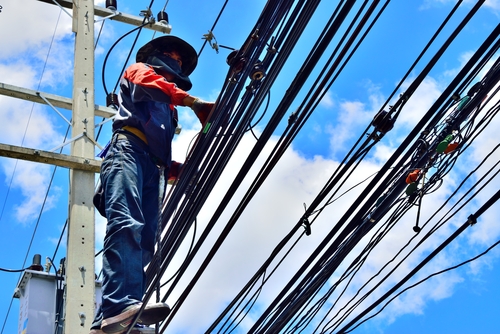Electrical utility workers are not the only ones who could be exposed to the hazards of overhead power lines. Any outdoor worker may be exposed to power line hazards. Yesterday, we covered four questions that all outdoor workers should ask if there are power lines near their work area. Today, we’ll cover two more.

At-risk workers must know when live high-voltage power lines are present in their work area or jobsite, and they must know to keep any conductive object—including the boom on boom-type equipment, long conductive objects like piping, and their own bodies—at a safe distance from the lines. It’s important that they understand why they have to stay away, and how far away they have to stay.
Why Do I Have to Observe Clearance Distances?
Most workers will readily understand that they must not come into direct contact with overhead lines, but they may find it harder to understand why they must keep anything conductive at a distance. They need to know that the insulation on high-voltage overhead lines is different.
Overhead lines are not insulated like building wiring. Wiring on household appliances is insulated to make it safe to touch, even when the appliance is in use. Wiring on overhead lines, however, is insulated only enough to protect it from weather conditions and incidental contact by trees. Because of this, electricity from power lines can arc— travel through the air—readily to make contact with a conductive object like a ladder, a tree saw, a dump truck bed, a crane boom, or a piece of irrigation piping.
Caring for injured employees and determining work relatedness of injuries and illness can be confusing and difficult to perfect. Join us on September 30th for this FREE webcast that will help remove the confusion surrounding work related injuries and illnesses.
Keeping people and objects a safe distance from overhead lines protects against the hazard of arcing.
This leads to our next question:
What is a “Safe Distance” from an Overhead Power Line?
If a power line has not been de-energized or insulated by the power company, it is important to keep workers and any conductive equipment far enough away to prevent electrical arcs. The required distance will depend on the voltage of the line.
- For overhead power lines of 50,000 volts (50 kV) or less, stay at least 10 feet away.
- For overhead power lines of more than 50,000 volts (50 kV) keep at least 35 feet away.
Have a Medical Treatment Case? Do you know how to identify and minimize OSHA recordability? Join this FREE Safety Webcast to learn how! Click here for more details.
Don’t forget that the clearance distance doesn’t just apply to workers’ bodies. It is absolutely vital that anything conductive stay outside the clearance distance. That includes:
- Workers’ bodies
- Any equipment they are using
- Any items they may be carrying
When you’re trying to keep workers safe, it can feel like there are too many questions you have to ask. Get the answers you need!
